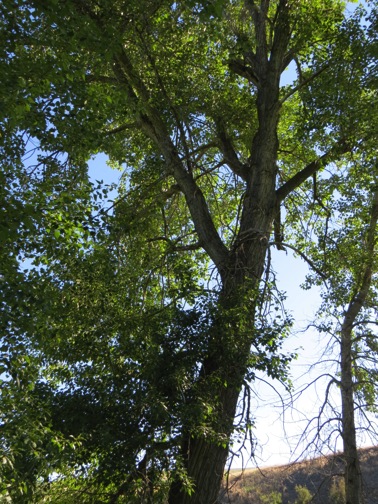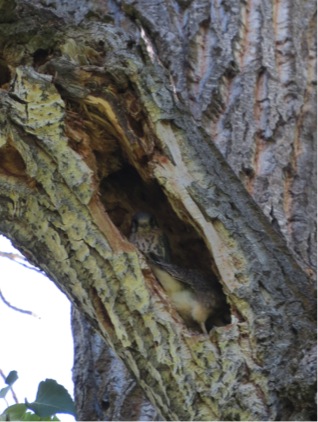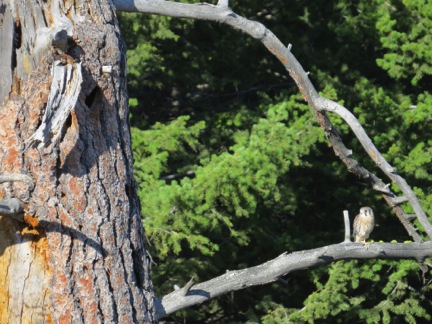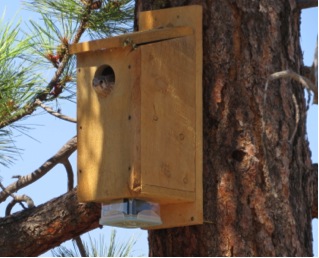
Kestrel Monitoring
Block title
 By: Kate StoneM.S. Avian Scientist
By: Kate StoneM.S. Avian ScientistIn partnership with Raptor View Research Institute, we monitor the occupation and fate of kestrel territories in both nest boxes and natural cavities. Monitoring over forty territories creates a challenge, particularly when nests occur in dense forest. Most of our nest boxes affix to telephone poles in open habitat where it is easy to see the adults and young. At forested nest sites, observations of prey deliveries or other activity proves difficult. Adults display cryptic behavior and fledged young hide in tree branches. The height of the cavity nests prevents location of an exact nest site. To pinpoint nests, we watch and listen for early-season territorial behavior of adults or listen for begging cries from the young. Despite consistent observation, we missed determining the exact nest tree for several territories this year.

I hear kestrels begging from this tree, but where is the nest? After several days of observation, I find the nest in a cavity about 60 feet high (top of photo).

A pair of nestlings peek out of the cavity.

This young male just left his cavity nest in a ponderosa pine snag.

Fluttering from tree to tree constitutes first flight for this fledgling female.

These four siblings spent days moving back and forth from their nest in a cottonwood snag to a nearby branch.

This kestrel box is outfitted with a custom PIT tag reader. PIT tags resemble microchips used on domestic pets. Tags glued to the leg-bands of adult and nestling kestrels emit unique signals that allow us to remotely identify individuals going in and out of the box. We monitor who incubates, who delivers food, and when the young fledge. Next year we hope to design a system effective for natural cavities.

About the AuthorKate Stone
Kate graduated from Middlebury College with a B.A. in Environmental Studies and Conservation Biology in 2000. She pursued a M.S. in Forestry at the University of Montana where her thesis focused on the habitat associations of snowshoe hares on U.S. National Forest land in Western Montana. After completing her M.S. degree in 2003, Kate alternated between various field biology jobs in the summer and writing for the U.S. Forest Service in the winter. Her fieldwork included projects on small mammal response to weed invasions, the response of bird communities to bark beetle outbreaks and targeted surveys for species of concern like the black-backed woodpecker and the Northern goshawk. Writing topics ranged from the ecology and management of western larch to the impacts of fuels reduction on riparian areas.
Kate coordinates bird-related research at the MPG Ranch. She is involved in both original research and facilitating the use of the Ranch as a study site for outside researchers. Additionally, Kate is the field trip coordinator and website manager for the Bitterroot Audubon Society. She also enjoys gardening and biking in her spare time.
Kate coordinates bird-related research at the MPG Ranch. She is involved in both original research and facilitating the use of the Ranch as a study site for outside researchers. Additionally, Kate is the field trip coordinator and website manager for the Bitterroot Audubon Society. She also enjoys gardening and biking in her spare time.



















